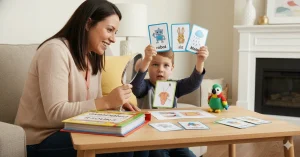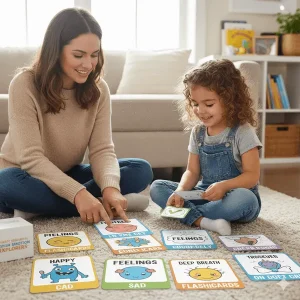Boost Your Child’s Focus: The Power of Short Breaks
Last Updated: September 16, 2024
In today’s fast-paced world, helping children stay focused can feel like a constant challenge. Focus plays a crucial role in a child’s ability to learn, complete tasks, and engage in everyday activities. Whether it’s paying attention in class, finishing homework, or simply following instructions, the ability to concentrate is key to their success and development. Yet, if you’re like many parents, you’ve probably noticed that maintaining that focus isn’t always easy for kids. They might get easily distracted, fidgety, or even frustrated when trying to stay on task for too long.
This struggle with concentration is completely normal—especially in a world filled with distractions like screens, noise, and the never-ending buzz of activity around them. But what if there was a simple way to help your child improve their focus without feeling overwhelmed? That’s where the concept of short breaks comes in. Research and experience both suggest that taking short, regular breaks can significantly enhance your child’s ability to stay on task and remain engaged.
Why Focus Matters for Kids
Have you ever noticed how much easier it is for your child to learn something new when they are truly paying attention? Focus isn’t just about sitting still; it’s about being mentally present and engaged. For kids, focus is like a superpower—it allows them to absorb information, follow through with tasks, and build skills that are essential for their overall development. Whether it’s learning to read, solving math problems, or even playing a new sport, being able to concentrate makes a world of difference.
When children can focus well, they not only perform better academically but also develop critical thinking and problem-solving skills. These skills are crucial not just in school but in everyday life, helping them navigate challenges, follow instructions, and complete tasks independently. Imagine your child struggling with a puzzle or a new concept in class. With good focus, they can tackle these challenges with determination and confidence. Without it, they might feel overwhelmed, leading to frustration and a lack of interest.
On the flip side, poor concentration can have a noticeable impact on a child’s academic performance and daily routines. When a child is easily distracted, even the simplest tasks can take much longer than they should. This can lead to a cycle of missed deadlines, incomplete assignments, and a lack of confidence in their abilities. It’s not just about schoolwork, though; difficulties with focus can spill over into other areas like social interactions, following rules, or even playing games, where patience and attention are key.
The Science Behind Short Breaks
Ever wondered why your child can focus intensely on something for a short while but then seems to lose interest just as quickly? This is because our brains are wired to work in short bursts of attention, especially for kids. Think of the brain like a muscle—it can only exert its strength for so long before it needs a break. When kids are working on tasks that require concentration, their brains are actively processing information, which can be mentally exhausting after a while.
Just like how a runner needs to pause to catch their breath, the brain needs moments to rest and recharge to keep functioning at its best. These short breaks are essential because they give the brain a chance to reset and recover, making it easier to jump back into the task with renewed focus and energy. Studies have shown that brief breaks can help improve attention, reduce mental fatigue, and even boost creativity. It’s not just about resting; it’s about letting the brain absorb what it’s learned, organize thoughts, and get ready for the next challenge.
When kids take regular short breaks, they are essentially giving their brains the downtime they need to maintain optimal performance. Imagine trying to sprint without stopping—you’d eventually get tired and slow down. The same goes for our brains; continuous, unbroken focus can lead to diminishing returns, where kids may struggle to retain information or complete tasks effectively.
Benefits of Short Breaks for Kids
Short breaks might seem small, but they can help your child a lot. Let’s look at how these breaks can improve focus, reduce stress, and boost creativity:
a. Improved Focus and Attention
Kids can start losing focus if they work for too long without a break. Short breaks help the brain rest and reset, making it easier for kids to get back to their tasks with fresh energy. It’s like pressing the reset button—it helps them concentrate better when they return to their work. Regular breaks keep your child’s attention sharp, whether they’re doing homework, learning something new, or even playing.
b. Reduced Stress and Fatigue
Long periods of focus can make kids feel tired and stressed. Taking a short break gives them a chance to relax and recharge. A quick break, like standing up, stretching, or taking a few deep breaths, can help lower stress and prevent feeling worn out. These simple pauses let them return to their tasks feeling calmer and more ready to continue.
c. Boosted Creativity and Problem-Solving
Sometimes the best ideas come when kids aren’t trying too hard. Short breaks allow their minds to wander a bit, which can help spark new ideas or solutions. Whether they’re stuck on a problem or thinking of ways to be creative, a quick break can give them the fresh perspective they need. By letting their minds rest, kids often come back with new ideas that they hadn’t thought of before.
How to Implement Short Breaks Effectively
Introducing short breaks into your child’s routine can be simple and very effective. Here’s how you can do it in a way that keeps your child’s focus sharp and their stress levels low:
a. Optimal Break Frequency and Duration
One of the best ways to use breaks is to follow a simple pattern, like the Pomodoro Technique. This method involves working for about 25-30 minutes and then taking a 5-10 minute break. For kids, this timing works well because it matches their natural attention span. After each work period, encourage your child to take a short break. This will help them reset and get ready for the next task. It’s a great way to keep them productive without feeling overwhelmed.
b. Types of Break Activities
During these short breaks, it’s important to choose activities that truly give the brain a rest. Here are some simple break ideas:
- Stretching: A quick stretch can help release tension and get blood flowing.
- Quick Exercises: Activities like jumping jacks or a short walk can boost energy levels.
- Breathing Exercises: Deep breathing or simple mindfulness exercises can calm the mind.
- Resting the Eyes: Looking away from screens or closing the eyes for a few minutes can help reduce eye strain.
These activities are easy and effective, providing the right kind of rest that helps kids stay focused when they return to their tasks.
Recommended Break Activities
| Activity | Description | Duration |
|---|
| Stretching | Encourage simple stretches like reaching arms overhead, touching toes, or gentle neck rolls. These movements help relieve muscle tension and improve blood circulation, making kids feel refreshed. | 2-3 minutes |
| Quick Exercises | Short bursts of activity like jumping jacks, skipping, or a brisk walk. These exercises boost energy levels and can help reduce restlessness, making it easier for kids to settle back into focused tasks. | 3-5 minutes |
| Breathing Exercises | Teach kids to take slow, deep breaths—inhale through the nose, hold for a few seconds, then exhale through the mouth. This helps calm the mind, lower anxiety, and reset attention spans, especially during stressful tasks. | 2-3 minutes |
| Resting Eyes | Have your child look away from screens, close their eyes, or focus on something distant, like looking out of a window. This reduces eye strain and refreshes their visual focus, essential for kids who spend time on screens or reading. | 1-2 minutes |
| Mindful Movement | Activities like simple yoga poses or gentle dance moves. These not only get the body moving but also help in connecting mind and body, promoting overall relaxation and focus. | 3-4 minutes |
| Creative Time | Encourage a quick drawing, doodling, or building with blocks. These creative outlets give the brain a break from structured tasks and can foster imagination and problem-solving skills. | 4-5 minutes |
c. Setting a Break Routine
Creating a consistent break routine can make these pauses feel natural and part of your child’s day. Start by setting a schedule that suits their needs—maybe a break every half hour of study or after each completed task. Consistency is key, so try to keep break times the same each day. You can even use a timer or fun reminders to signal when it’s time for a break. This way, breaks become a normal part of their routine, helping them to maintain focus without feeling like they’re always working.
Common Mistakes to Avoid
While short breaks can be a great tool for improving your child’s focus, there are some common mistakes that can make these breaks less effective. Let’s look at a few pitfalls to avoid so that breaks work their best:
1. Allowing Screen Time During Breaks
It might be tempting to let your child watch a quick video or play a game during their break, but screen time isn’t the best way for the brain to rest. Screens can be overstimulating and may actually make it harder for your child to refocus afterward. Instead, encourage activities that truly allow the brain to relax, like stretching, taking deep breaths, or simply looking out the window.
2. Making Breaks Too Long
Breaks that are too long can make it difficult for your child to get back on task. A short break should be just that—short. Aim for breaks that are 5-10 minutes long. This gives enough time for a quick reset without losing momentum. If breaks stretch too long, your child might lose their focus altogether, making it harder to resume their work.
3. Lack of Structure and Purpose
For breaks to be effective, they should be structured and purposeful. This doesn’t mean they have to be rigid, but having a clear start and end time helps your child understand that the break is just a pause, not a complete stop. It’s also important that breaks are used wisely—activities should be calming or energizing, not distracting. A good routine, like taking a few minutes to stretch or go for a quick walk, keeps the break focused and beneficial.
Conclusion
Short breaks are an easy way to help your child focus better, feel less stressed, and think more creatively. When kids take short, regular breaks, it gives their brains a chance to rest and reset. This makes it easier for them to get back to tasks and stay engaged. Whether it’s during homework, reading, or any other activity, short breaks can make a big difference in how your child feels and performs.
If your child struggles with concentration, try adding 5-10 minute breaks after every 25-30 minutes of focused work. Encourage simple activities like stretching, deep breathing, or just resting their eyes. Keep the breaks short and free from distractions like screens. Watch how these small pauses help your child feel more relaxed and attentive. Every child is different, so it might take some time to find what works best. For more tips on supporting your child’s focus and well-being, visit WellnessHub to explore our helpful resources.
Frequently Asked Questions:
1. How do short breaks improve my child’s focus?
Short breaks give your child’s brain a chance to rest and reset, making it easier for them to refocus on tasks. This helps them stay engaged and attentive, especially during learning or homework.
2. What is the best length for a break to help my child focus?
A break of about 5-10 minutes after 25-30 minutes of focused work is usually effective. This timing aligns with your child’s natural attention span, allowing them to recharge without losing momentum.
3. What are some good activities for short breaks?
Simple activities like stretching, quick exercises, deep breathing, or resting the eyes are great for short breaks. These activities help relax the brain and prepare your child to return to their tasks with renewed focus.
4. Can screen time be used as a break for my child?
It’s best to avoid screen time during breaks, as it can be overstimulating and may make it harder for your child to refocus afterward. Opt for activities that calm the mind and body instead.
5. How often should my child take breaks when studying?
A good rule of thumb is to take a short break every 25-30 minutes of focused work. This can help keep your child’s energy levels up and prevent burnout.
6. How can I set a good break routine for my child?
To set a good break routine, keep the schedule consistent. Use a timer or set reminders to help your child know when it’s time for a break. Consistency helps make breaks a regular part of their routine, keeping them structured and effective.
7. Why are breaks important for kids’ mental health?
Breaks are important because they reduce stress and prevent mental fatigue. They give your child a moment to relax, which can help improve their mood and overall well-being.
8. What are the common mistakes to avoid when using short breaks?
Avoid letting breaks turn into long periods of downtime or allowing screen time, which can reduce the effectiveness of the break. Keep breaks short, purposeful, and free from distractions.
9. Can short breaks help with my child’s creativity?
Yes, short breaks can boost creativity by giving the brain time to wander and think freely. This can lead to fresh ideas and better problem-solving skills when your child returns to their tasks.
10. How can I see if short breaks are working for my child?
Observe your child’s behavior and focus after introducing short breaks. Are they more attentive, less stressed, or more creative? Adjust the timing and activities based on what works best for them.
About Author:
Lasya Vooturi,
Clinical Psychologist (A) & Behavioral Therapist
Lasya holds a Professional Diploma in Clinical Psychology from Amity University, where she deepened her understanding of psychological principles from March 2023 to March 2024. With over a year of dedicated experience as a Behavioral Therapist, Lasya has honed her skills in applying effective therapy techniques tailored to individual needs. Fluent in Telugu, Hindi, and English, she is adept at connecting with a diverse range of clients, ensuring comprehensive communication and understanding. Lasya’s approach is grounded in empathy and scientific rigor, making her a trusted ally in navigating mental health challenges.
Book your Free Consultation Today
Parent/Caregiver Info:
Client’s Details:
* Error Message









